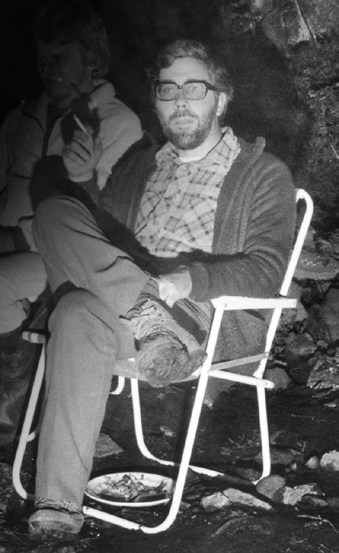Allan Ockenden and Graham Bessant remember Martin Hatton who left us on 24th August 2023

Martin was a very popular member of the Club for many years and will be remembered as a source of convivial conversation in the New Inn or around the cottage fire. He was a regular on many trips to Yorkshire, Ireland and elsewhere, and became a leading figure in the establishment of Pen Fathor as the Clubs first cottage in Wales and then the subsequent work to fit out Selwyn’s barn at the New Inn for Club use.
When the opportunity to buy Godre Pentre arose, Martin was one of a small consortium of members who purchased it on the Club’s behalf before we were able to raise funds for the Club to take ownership.
Martin had a strong interested in the Stone mines of Surrey and was a key player in the early exploration of Merstham Mines. He was particularly interested in the history of the mines and later wrote a detailed dissertation about their history as part of his Archeology Masters degree at Birkbeck College in 2001.
In more recent years, Martin’s interest moved away from Caving to Archaeology. Whilst always remaining a Club member he was more often seen mudlarking on the Thames tideway or excavating archaeological sites in East Anglia where he became an expert in the analysis of skeletal remains.
Martin lived all his life in the same house at Clapham in London where he assembled a large library of caving books. These he kindly donated to the Club along with other Club records and surveys a few years ago.
Martin’s health deteriorated in recent years and he eventually lived in a nursing home in the New Forest to be near his brother. He did not want all the fuss of a formal funeral event and opted for a simple cremation dressed in his archeological digging clothes and with his digging trowel at his side. This took place on 21st September 2023.
Martin joined the Club with some work colleagues, one of which, Graham Bessant, has supplied his own memories below.
Allan Ockenden
I have known Martin since the age of 11 years old when we were in the 25th Battersea Air Scout troop. There were some five of us who lived around Clapham Common and remained friends after we left the scouts.
Martin was not a greatly practical person, but loved playing bridge and his unrivalled ability to remember who had played what cards enabled him to win almost every rubber. In fact, in his younger days Martin always carried a pack of playing cards with him and would attempt to start a game at the slightest opportunity.
Martin always liked to be outdoors and every Bank Holiday three of us would go Youth Hostelling. It was on one of these breaks in the Lake District that Martin told of his wish to go caving. We had bought a single ticket on the Ravenglass and Eskdale railway and having disembarked at Eskdale we walked up the Hardknott pass and then turned east and trekked across the moors to Coniston Copper Mines Youth Hostel. We were nearly there when we stopped at an old mine entrance and Martin spoke of his admiration for cavers and said he would love to try caving. His chance came a few months later when he met Robin Walls and went on a beginner’s trip. He really enjoyed the experience and asked me if I would come down to the Croydon Caving Club with him. That was the start of Martin’s involvement with caving.
Martin’s other great love was debating and whatever the subject Martin would always speak at length even when he knew little about the subject. We spent many hours in pubs debating politics, history, philosophy etc. and Martin would always remain in good humour whatever the outcome. His eternal good humour was another of Martin’s great strengths.
I don’t remember Martin ever being in a bad mood and he would always adopt a positive manner. I remember when my appalling old Hillman Minx suffered a major loss of brake fluid, Martin was unperturbed and told me “just drive with normal driving confidence”. Martin’s good humour was still in evidence during the last stages of his illness. I phoned him to find out how he was getting on and this developed into a discussion on history, archaeology and current affairs. His mind remained razor sharp but the Parkinson’s disease was seriously impairing his speech, however this did not affect his wish to expound on all of the topics.
After retiring Martin transferred his interests to archaeology, and during the summer months he would transfer to Sedgeford in Norfolk where he could indulge his passion for outdoor activities in excavating and once he had found artefacts he could then debate on their origins and significance in the pub in the evenings. At other times of the year Martin would go “mudlarking” in the Thames around Greenwich. He once asked me to meet him at Greenwich and I spent a few hours looking at rotten timber stumps on the foreshore which Martin believed were the remains of a Tudor pier, of course a lengthy debate ensued.
Martin’s other trade mark was his appearance, his physical appearance did not change until the last two years of his life, and he always wore the same style of clothes: black, elastic sided boots; black corduroy trousers; a check shirt; and a yellow or red cable knit jersey together with a blouson type jacket.
Altogether a very intelligent, amusing and good natured person, he will be missed.